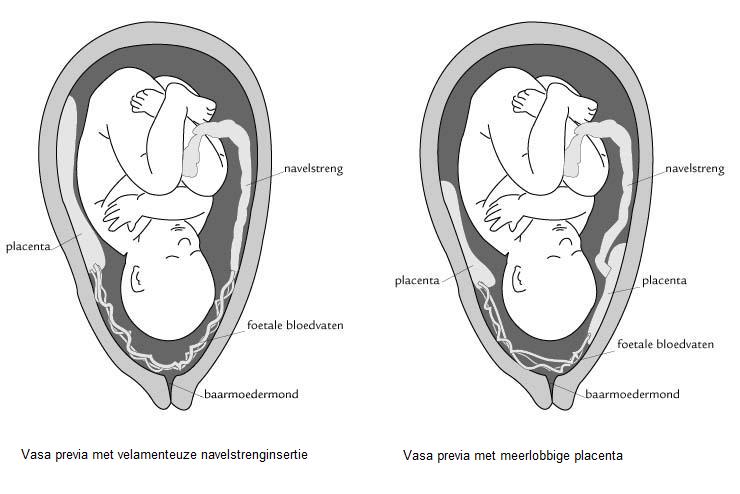- Vasa praevia
Infobox_Disease
Name = PAGENAME

Caption = Vasa praevia
DiseasesDB = 13743
ICD10 = ICD10|O|69|4|o|60
ICD9 = ICD9|663.5
ICDO =
OMIM =
MedlinePlus =
eMedicineSubj = med
eMedicineTopic = 3276
MeshID =Vasa praevia (vasa previa AE) is an obstetric complication defined as "fetal vessels crossing or running in close proximity to the inner
cervical os . These vessels course within the membranes (unsupported by the umbilical cord or placental tissue) and are at risk of rupture when the supporting membranes rupture." [cite journal | author = Yasmine Derbala, MD; Frantisek Grochal, MD; Philippe Jeanty, MD, PhD | title = Vasa previa | journal = Journal of Prenatal Medicine 2007 | volume = 1 | issue = 1 | pages = 2-13 | year = 2007 | id = " [http://www.prenatalmedicine.com/materiale_cic/232_I_1/2170_vasa/article.pdf Full text] "]Etiology/Pathophysiology
Vasa previa is present when fetal vessels traverse the fetal membranes over the internal cervical os. These vessels may be from either a velamentous insertion of the umbilical cord or may be joining an accessory (succenturiate) placental lobe to the main disk of the placenta. If these fetal vessels rupture the bleeding is from the fetoplacental circulation, and fetal exsanguination will rapidly occur, leading to fetal death.
Presentation
These vessels may be torn at the time of labor,
delivery or when the membranes rupture. It has a high fetal mortality because of the bleeding that follows. [cite journal | author = Oyelese K, Turner M, Lees C, Campbell S | title = Vasa previa: an avoidable obstetric tragedy. | journal = Obstet Gynecol Surv | volume = 54 | issue = 2 | pages = 138–45 | year = 1999 | pmid = 9950006 | doi = 10.1097/00006254-199902000-00024]The classic triad are membrane rupture followed immediately by "painless" vaginal bleeding and fetal
bradycardia .Risk Factors
Vasa previa is seen more commonly with velamentous insertion of the umbilical cord, accessory placental lobes, and multiple gestation.
Diagnosis
* This is rarely confirmed before delivery but may be suspected when antenatal sono-gram with color-flow Doppler reveals a vessel crossing the membranes over the internal cervical os. [cite journal | author = Lijoi A, Brady J | title = Vasa previa diagnosis and management. | journal = J Am Board Fam Pract | volume = 16 | issue = 6 | pages = 543–8 | year = | pmid = 14963081" [http://www.jabfm.org/cgi/content/full/16/6/543 Full text] "] [cite journal | author = Lee W, Lee V, Kirk J, Sloan C, Smith R, Comstock C | title = Vasa previa: prenatal diagnosis, natural evolution, and clinical outcome. | journal = Obstet Gynecol | volume = 95 | issue = 4 | pages = 572–6 | year = 2000 | pmid = 10725492 | doi = 10.1016/S0029-7844(99)00600-6]
* The diagnosis is usually confirmed after delivery on examination of the placenta and fetal membranes.
* Most often the foetus is already dead when the diagnosis is made; because the blood loss (say 300ml) constitutes a major bulk of blood volume of the foetus (80-100ml/kg i.e. 300ml approx for a 3kg foetus).Treatment
Treatment "immediately" with an emergency cesarean delivery is usually indicated. [cite journal | author = Bhide A, Thilaganathan B | title = Recent advances in the management of placenta previa. | journal = Curr Opin Obstet Gynecol | volume = 16 | issue = 6 | pages = 447–51 | year = 2004 | pmid = 15534438 | doi = 10.1097/00001703-200412000-00002] [cite journal | author = Oyelese Y, Smulian J | title = Placenta previa, placenta accreta, and vasa previa. | journal = Obstet Gynecol | volume = 107 | issue = 4 | pages = 927–41 | year = 2006 | pmid = 16582134]
ee also
*
Placenta praevia References
External links
* [http://www.ivpf.org International Vasa Previa Foundation]
* [http://www.vasapraevia.co.uk UKVP - Raising Awareness]
* [http://www.vasaprevia.nl Vasa Previa Foundation Netherlands]
* [http://www.thefetus.net/page.php?id=188 TheFetus.net - vasa previa ultrasound images]
* [http://www.thefetus.net/listing.php?id=2183 TheFetus.net - vasa previa lectures]
* [http://www.medterms.com/script/main/art.asp?articlekey=5961
Wikimedia Foundation. 2010.
